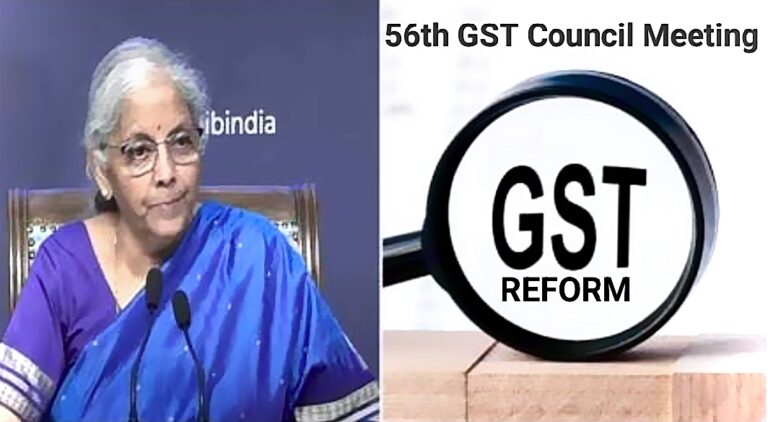Introduction
The Goods and Services Tax (GST) regime in India has undergone its most significant transformation since its launch in 2017. In the 56th GST Council meeting held on September 3, 2025, the government unveiled a historic reform package aimed at simplifying tax rates, easing compliance, and boosting consumer demand. A landmark decision was the complete GST exemption on individual life and health insurance premiums, making essential protection more affordable for millions of Indians. Alongside, the Council rationalized the tax structure from the earlier four slabs to a simplified two-tier system, with select luxury and sin goods attracting a higher “de-merit” rate. These reforms, set to take effect from September 22, 2025, mark a new chapter in India’s indirect tax framework, promising relief to households, businesses, and industries alike.
1. A Simplified, Citizen-Friendly Tax Structure
- The GST Council, in its 56th meeting held on September 3, 2025, approved sweeping changes under the banner of “Next-Gen GST Reform”.
- The existing four-tier system (5%, 12%, 18%, 28%) has been restructured into two primary slabs—5% (Merit Rate) and 18% (Standard Rate)—plus a special 40% “de-merit” rate for selected sin and luxury goods.
2. GST Exemption on Life & Health Insurance
- A historic decision: All individual life and health insurance premiums (term, ULIP, endowment, family floater, senior citizen policies), including reinsurance, will be completely exempt from GST—slashed from the previous 18% to 0%.
- The move is touted as making insurance more affordable and boosting coverage across the population.
- The financial market also responded positively—insurance stocks, including ICICI Prudential and LIC, rallied up to 6% following news of the exemption.
⏰ 3. Implementation Timeline
- The new GST structure—with the two-tier model and 0% exemption on insurance—will come into effect on September 22, 2025, coinciding with the start of Navratri.
- Notably, sin goods such as cigarettes, pan masala, gutkha, unmanufactured tobacco, and beedis will continue under existing GST plus compensation cess rules for the time being, until relevant cess-related liabilities are fully cleared.
4. Key Items Receiving GST Relief
A broad array of daily-use items and essentials have seen GST rates slashed to 5%—and in some cases, nil:
- Nil (0%) GST on UHT milk, packaged paneer, and all Indian breads (like roti, chapati, parotta).
- Items dropped to 5% include hair oil, soaps, shampoos, toothpaste, toothbrushes, bicycles, tableware, kitchenware, packaged namkeen, sauces, pasta, instant noodles, chocolates, coffee, cornflakes, butter, ghee, medical devices and apparatus, and agricultural equipment.
- Small cars, air-conditioners, televisions above 32 inches, appliances, and auto parts have moved from 28% to 18%, bringing big-ticket expenses down.
- Even three-wheelers, cement, buses, trucks, ambulances are standardized at 18%.
- Certain luxury or high-end vehicles, SUVs, motorcycles over 350 cc, and sin products are now taxed at 40% under the new de-merit slab.
5. Broader Economic & Fiscal Impact
- The GST restructure is expected to spur consumption, especially ahead of the festive season, with FMCG companies and dairy producers like Mother Dairy promising to pass on cost savings to consumers.
- Financially, the government estimates an ₹48,000 crore impact in net revenues—deemed manageable and fiscally sustainable by both the Centre and states.
- Industry experts—spanning automotive, FMCG, insurance, and advisory sectors like Mahindra, EY, Deloitte, HDFC ERGO, Kotak AMC—have welcomed the measures, calling them transformative and expansionary.
- Structural improvements accompany the rate changes: launch of the GST Appellate Tribunal (GSTAT), simplified GST registration for e-commerce, enhanced refund mechanisms, and improved valuation rules.
6. Conclusion
The 2025 GST reforms represent a bold step toward creating a simpler, fairer, and more consumer-friendly tax system. By exempting life and health insurance from GST and rationalizing the rate structure into a two-tier system, the government has addressed long-standing concerns of both households and businesses. The relief on essential goods and services is expected to lower costs, spur consumption, and bring tangible benefits to the common man, while industries anticipate higher demand and smoother compliance. As the changes roll out from September 22, 2025, they are set to redefine India’s indirect taxation landscape—marking a new era where growth, affordability, and ease of doing business go hand in hand.
